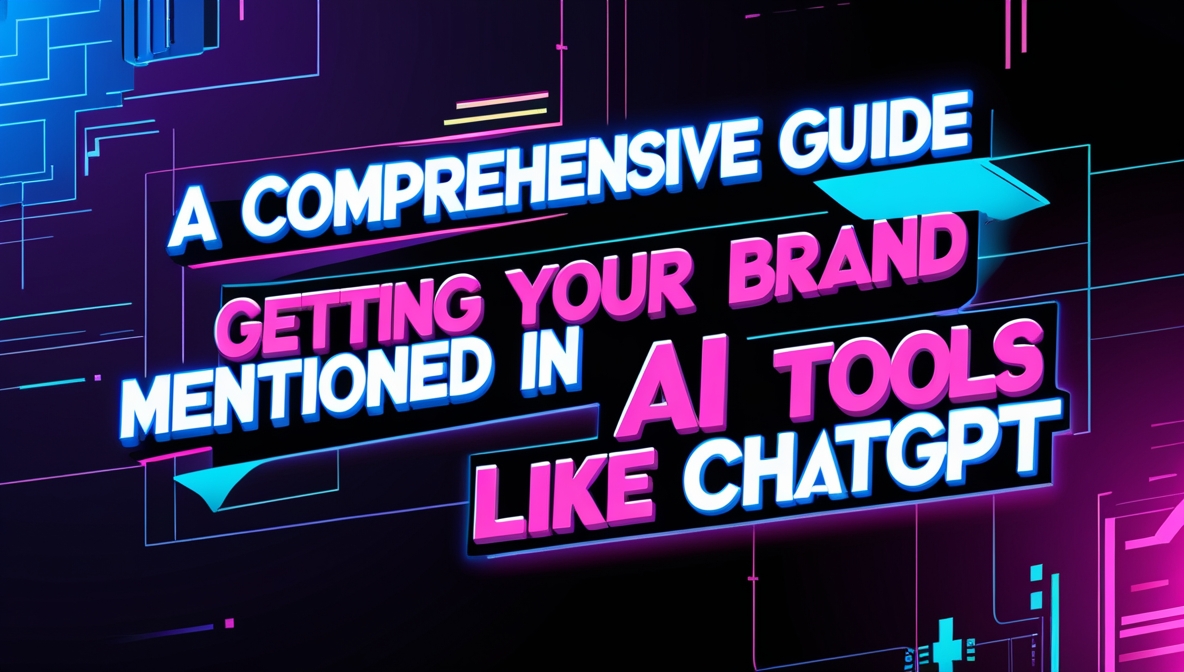A Comprehensive Guide to Getting Your Brand Mentioned in AI Tools Like ChatGPT
How to Get Your Brand Recognized by ChatGPT and Other AI Tools
*** This blog is available to download in PDF – Includes Bonus content ***
In the rapidly evolving world of artificial intelligence (AI), large language models (LLMs) such as ChatGPT are shaping how individuals and businesses access information.
When a user asks ChatGPT about products, services, or thought leaders in your industry, wouldn’t it be great if your brand was part of the conversation?
Getting mentioned by LLMs—especially in positive and accurate ways—can help increase your online visibility, drive traffic, and even boost your credibility among prospective customers or clients.
However, unlike social media platforms or search engines, these AI models don’t take immediate updates from real-time sources (unless they have specific plugins or custom fine-tuning). Instead, they rely on training data collected from web pages, books, news articles, and more.
If your brand is not present—or is underrepresented—in these sources, the model simply won’t know you exist.
In this blog, we’ll explore actionable steps to boost the odds of your brand being recognized by AI models like ChatGPT, and we’ll look at specialized monitoring tools (including TryProFound) that help you understand if and how these models mention you.
1. Understanding How LLMs Acquire Information
Large language models such as GPT-3.5, GPT-4, and other transformer-based architectures are trained on massive text corpora pulled from:
- Publicly available websites, articles, and blogs
- Academic papers, books, and digital libraries
- Code repositories and Q&A forums for specialized content
Once an LLM’s training is complete, it forms an internal “understanding” of concepts, names, and ideas based on that text.
If your brand doesn’t appear (or doesn’t appear often) in these sources, there’s little chance the model will reference it—simply because it was never exposed to the data during training.
2. Why Getting Mentioned in LLMs Can Be Beneficial
Increased Exposure: ChatGPT and other models are widely used for research, content creation, and customer support. If your brand appears in relevant answers, it’s free, organic publicity.
Enhanced Credibility: People often rely on AI for quick insights. Consistent positive mentions of your brand can build trust and authority.
Cross-Platform Influence: A strong digital presence that also shows up in AI-driven search or chat contexts can amplify your marketing efforts across other platforms as well.
3. Build Your Online Presence
To improve the likelihood that your brand ends up in future versions of AI models, focus on amplifying your digital footprint:
- Authoritative Website Content:
- Create a well-structured, SEO-friendly website.
- Publish in-depth blog posts, whitepapers, or case studies showcasing your brand’s expertise.
- Ensure your site is frequently crawled by search engines (fresh content, well-organized sitemap).
- Leverage Social Media:
- Engage actively on platforms like Twitter (X), LinkedIn, or Facebook.
- Encourage influencers in your field to mention or review your brand.
- Monitor and participate in relevant community forums and discussion boards.
- Claim a Wikipedia Presence:
- If your brand meets
Wikipedia’s notability guidelines, you can create or contribute to a page. - Keep the entry neutral, well-cited, and fact-based.
- Wikipedia content is frequently included in LLM training corpora.
- If your brand meets
- Guest Posting & PR:
- Write guest articles for reputable industry websites or blogs.
- Issue press releases through platforms that distribute to major news outlets.
- Press coverage in mainstream outlets has a high chance of being in AI training data.
4. Tools to Monitor Your Brand’s Mentions
Even the best SEO strategy or social media campaign won’t help if you’re not actively tracking how your brand is perceived and discussed online.
Below are some widely used tools that focus on traditional web and social media monitoring. In the next section, we’ll look at how new, specialized tools help track mentions in AI conversations specifically.
- Mention | https://mention.com | Tracks real-time references of your brand across the web and social media. Offers sentiment analysis and helps identify key influencers talking about you.
- Brand24 | https://brand24.com | Monitors social media, blogs, news sites, and forums, providing valuable insights on how your brand is perceived. Also includes alerts and competitor analysis.
- Awario | https://awario.com | Tracks brand mentions in real-time, with a focus on social channels and web sources. Provides sentiment analysis and audience insights.
- BrandMentions | https://brandmentions.com | Offers a comprehensive dashboard of social media and web mentions, plus sentiment tracking. Good for agencies managing multiple brands.
- Talkwalker | https://www.talkwalker.com | An enterprise-level tool with advanced social listening, image recognition, and global coverage for brand monitoring.
- Google Alerts |https://alerts.google.com | A free, lightweight solution to keep tabs on mentions across Google’s search index. Not as powerful as paid options, but a good starting point for small brands.
5. Brand Mentions in AI Contexts: Spotlight on TryProFound
While the tools mentioned above focus on tracking social networks and the public web, TryProFound tackles the emerging challenge of monitoring and analyzing how Generative AI models reference your brand.
As AI-driven conversations become more prevalent—think ChatGPT plugins, custom chatbots, or enterprise AI solutions—companies need ways to see how and where their brand names or products appear in these conversational experiences.
Key Capabilities of TryProFound:
- LLM Mention Detection: The ability to detect if and how your brand or product is referenced within AI-generated text.
- Real-Time Insights: In some cases, can gather near real-time feedback on brand mentions, particularly for internal AI-driven support chats or third-party integrations where data access is shared.
- Content Accuracy & Sentiment: Beyond surface-level mentions, some specialized tools help you assess if the mention is factually correct and whether the sentiment is positive, negative, or neutral.
Why It Matters:
- Factual Integrity: AI can “hallucinate” or produce inaccuracies. Getting quick insights into these references allows you to correct misconceptions promptly.
- Brand Reputation: Understanding the tone and context in which AI references your brand helps you address negative sentiment or reinforce positive buzz.
- Competitive Analysis: Some platforms let you compare how often competitor names appear relative to yours, giving you data for market positioning.
Keep in mind that collecting data from AI conversation logs must comply with user privacy, data protection rules, and enterprise security policies.
However, if you run your own AI chatbot—or have authorized access to conversation logs—tools like TryProFound can provide critical visibility into AI-powered customer interactions.
6. Other AI Conversation Monitoring Solutions
As this is a nascent market, relatively few off-the-shelf platforms focus exclusively on LLM or AI conversation analytics for brand mentions. However, a few existing or emerging solutions do offer overlapping capabilities:
- Clarabridge (Part of Qualtrics):Known for text analytics and “voice of the customer” monitoring. While not specifically built for LLM monitoring, it can analyze large volumes of chat data, flag brand mentions, and gauge sentiment if integrated with your AI/chatbot logs.
- Observe.AI / CallMiner:Primarily for contact centers, these platforms record and analyze calls and chat sessions. With the right integration, they can track brand references during AI-assisted or agent-led conversations.
- Sprinklr and Brandwatch:Major players in social listening and customer experience management. They increasingly incorporate AI-driven text analytics, so if you feed them transcripts of AI chatbot interactions, they can help monitor brand mentions.
- Signal AI:Focused on multi-channel media monitoring and “decision augmentation.” If your brand references appear in text logs—public or internal—Signal AI’s advanced NLP can analyze mentions, track sentiment, and classify topics.
Additionally, new startups in “generative AI conversation intelligence” continue to emerge. Searching “LLM analytics” or “ChatGPT brand monitoring” on tech directories (like G2, Capterra, or Product Hunt) may reveal newer entrants.
7. Engage in Open-Source and Technical Communities
If your product or service has a strong technical angle, consider these community-based approaches:
- GitHub Repositories: Open-source your projects or libraries under your brand’s name. Developer communities sometimes contribute code or references that end up in AI training sets.
- Technical Q&A: If customers or developers frequently ask about your product on Stack Overflow or Reddit, share detailed, accurate answers that reinforce your brand credibility.
- Developer Documentation: Publicly accessible docs describing your brand’s solutions in depth can end up being ingested by future AI models.
8. Create High-Quality Content About Your Brand
One of the biggest factors in shaping future LLM updates is content quality. Random mentions of your brand in questionable or “spammy” locations might not make the cut, but well-crafted, insightful content has a better chance of being retained.
- Thought Leadership: Publish articles, opinion pieces, or blog posts on industry trends to showcase your brand’s authority.
- User Guides & Tutorials: Provide real value by sharing how-to guides, tutorial videos, or step-by-step PDF manuals.
- Webinars & Podcasts: The transcripts from your webinars or podcasts can be indexed and potentially appear in the textual data used by AI models.
9. Be Prepared for Model “Cutoff Dates”
Remember that many publicly available LLMs are not updated continuously:
- Training Cutoff: A model might only include data up to a certain date.
- Periodic Updates: Tools like ChatGPT will occasionally release new versions with updated training data.
If your brand is making waves now, it may not show up in an AI model’s responses immediately. Your efforts to build and monitor your brand’s online presence can bear fruit once the model re-trains or updates its dataset.
10. The Long Game: Consistency, Credibility, and Clarity
Brand visibility in AI isn’t achieved overnight. Even if you follow every step—publish high-quality content, engage on social media, build a Wikipedia page, monitor mentions with both general and AI-focused tools—it can take months or longer before an LLM meaningfully reflects your brand.
Stay consistent:
- Produce reliable, shareable content on a regular schedule.
- Engage with your community and customers: positive word-of-mouth often leads to organic mentions on forums or social media, which, in turn, feed training data.
- Monitor your reputation using a combination of mainstream monitoring (e.g., Mention, Brand24) and specialized AI-focused solutions like TryProFound.
- Be prepared to correct inaccuracies: If an AI model “hallucinates” incorrect information about your brand, publish clear and accessible data that can be picked up in the next training cycle.
Conclusion
Securing consistent brand mentions in AI models like ChatGPT is an emerging discipline that requires a robust, holistic approach.
The formula is simple enough in principle: the more credible, relevant coverage your brand has online, the higher your chances of being recognized by AI models in the future.
Meanwhile, specialized tools—such as TryProFound—can help you monitor brand references within AI-driven conversations, offering insights that traditional social listening platforms might miss.
Whether you’re a startup, a small business, or an established enterprise, being patient and strategic is key.
By focusing on high-quality content, relationship-building with influencers, and continuous brand monitoring across both traditional and AI-driven channels, you’ll position your brand to appear naturally and accurately in the next wave of AI-generated answers.
*** This blog is available to download in PDF – Includes Bonus content ***



